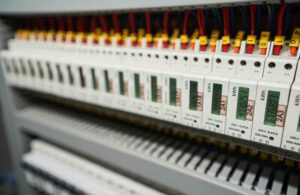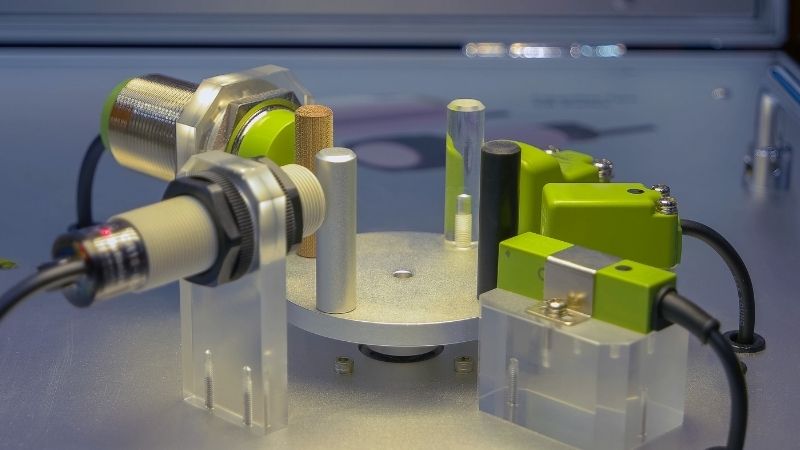3 Kablolu Endüktif Yakınlık Sensörleri: Tam Kılavuz
Bu kapsamlı kılavuzda, temel prensiplerden pratik uygulamalara kadar her şeyi inceleyerek otomasyon ihtiyaçlarınız için bilinçli kararlar almanıza yardımcı olacağız.
İçindekiler
3 Kablolu Endüktif Yakınlık Sensörü Nedir ve Nasıl Çalışır?
3 telli endüktif yakınlık sensörü, fiziksel temas olmadan metalik nesneleri algılayan elektronik bir cihazdır. Bu sensörler, iletken hedeflerin varlığını veya yokluğunu algılamak için elektromanyetik alanlar kullanır. Geleneksel mekanik anahtarların aksine, endüktif sensörler birkaç avantaj sunar:
- Tespit için fiziksel temas gerekmez
- Mekanik aşınma olmaması nedeniyle uzun çalışma ömrü
- Yüksek anahtarlama frekansı yetenekleri
- Endüstriyel ortamlara karşı mükemmel direnç
Sensör, algılama yüzeyinden bir elektromanyetik alan üreterek çalışır. Metalik bir hedef bu alana girdiğinde, hedefte girdap akımları indüklenir ve sensörün osilatör devresinde bir değişikliğe neden olur. Bu değişiklik, çıkışın durumları değiştirmesini tetikler.
PNP ve NPN: Hangi Çıkış Yapılandırmasını Seçmelisiniz?
3 kablolu yakınlık sensörü seçerken en kritik kararlardan biri PNP ve NPN çıkış tipleri arasında seçim yapmaktır. Farkları inceleyelim:
PNP (Kaynak) Çıktısı:
- Yüke pozitif voltajı geçirir
- Avrupa uygulamalarında yaygın
- PLC batık girişlerine bağlanır
- Elektriksel gürültüye karşı daha dirençli
NPN (Batan) Çıkışı:
- Anahtarlar yüke topraklanır
- Asya pazarlarında popüler
- PLC kaynak girişlerine bağlanır
- Genellikle daha az masraflıdır
PNP ile NPN arasındaki seçim genellikle mevcut kontrol sisteminize ve bölgesel tercihlerinize bağlıdır. Endüstriyel sensörler hakkında daha fazla bilgi edinin Detaylı özellikler için.
3 Kablolu Yakınlık Sensörünüzü Nasıl Kurar ve Bağlarsınız?
Optimum sensör performansı için doğru kurulum ve bağlantı çok önemlidir. İşte adım adım bir kılavuz:
- Güç Kaynağı Bağlantısı:
- Kahverengi tel → Pozitif DC voltajı (tipik olarak 12-24V DC)
- Mavi tel → Negatif/Toprak
- Siyah tel → Çıkış sinyali
- Montaj Hususları:
- Uygun algılama mesafesini koruyun
- Yakındaki metal nesnelerden kaynaklanan parazitlerden kaçının
- Çevresel faktörleri (sıcaklık, titreşim) göz önünde bulundurun
- Yük Bağlantısı:
- Yükü çıkış ve güç kaynağı arasına bağlayın
- Uygun voltaj ve akım değerlerini sağlayın
- Uygun aşırı gerilim korumasını kullanın
PLC entegrasyon kılavuzumuzu inceleyin Detaylı otomasyon sistemi bağlantıları için.
Yaygın Uygulamalar ve Endüstriyel Kullanımlar
3 kablolu endüktif yaklaşım sensörleri çeşitli endüstriyel uygulamalarda yaygın olarak kullanılmaktadır:
| Başvuru | Faydalar | Ortak Endüstriler |
|---|---|---|
| Pozisyon Algılama | Yüksek doğruluk, hızlı tepki | Otomotiv, Paketleme |
| Metal Algılama | Güvenilir çalışma, uzun ömür | Üretim, Madencilik |
| Hız İzleme | Hassas ölçüm, dayanıklılık | Konveyör Sistemleri |
Bu sensörler özellikle şu konularda değerlidir: otomatik üretim hatları Ve robotik uygulamalar.
Sorun Giderme ve Bakım İpuçları
Güvenilir bir çalışma sağlamak için şu bakım uygulamalarını göz önünde bulundurun:
- Algılama yüzeyinin düzenli temizliği
- Bağlantı bütünlüğünün periyodik olarak kontrol edilmesi
- Uygun hizalamanın doğrulanması
- Besleme gerilimi kararlılığının izlenmesi
Sıkça Sorulan Sorular
Tipik algılama aralıkları, sensör boyutuna ve hedef malzemeye bağlı olarak 1 mm ile 40 mm arasında değişmektedir.
3 kablolu sensörler ayrı güç ve çıkış bağlantıları sunarak daha esnek entegrasyon ve daha iyi performans sağlar.
Hayır, endüktif sensörler yalnızca metalik nesneleri algılamak için özel olarak tasarlanmıştır. Metalik olmayan malzemeler için şunları göz önünde bulundurun: kapasitif veya fotoelektrik sensörler.
Çoğu sensörde algılama durumunu ve düzgün çalışmayı gösteren bir LED göstergesi bulunur.
Projelerinize yepyeni, orijinal Omron, Keyence, Schneider Sensörlerle güç verin – stokta, hemen kullanıma hazır!
Çözüm
Önemli Noktalar
- 3 kablolu endüktif yakınlık sensörleri modern endüstriyel otomasyonun temel bileşenleridir
- Sistem gereksinimlerinize göre PNP ve NPN çıkışları arasında seçim yapın
- Uygun kurulum ve bakım güvenilir çalışmayı garanti eder
- Düzenli sorun giderme, kesintileri önler ve sensör ömrünü uzatır
- Sensörleri seçerken ve kurarken çevresel faktörleri göz önünde bulundurun
Otomasyon uzmanlarımızla iletişime geçin Sensör uygulamalarınızda kişiselleştirilmiş yardım için.
Bize Ulaşın
Bu forma adınızı, e-posta adresinizi ve sorunuzun kısa bir açıklamasını girmeniz yeterlidir. 24 saat içinde sizinle iletişime geçeceğiz.
Bu Konuları da İlginizi Çekebilir

PLC Programlama Kılavuzu: Endüstriyel Otomasyonda Ustalaşın
Programlanabilir Mantık Denetleyicileri (PLC'ler) dünyasını ve endüstriyel otomasyonu nasıl devrimleştirdiklerini anlamak mı istiyorsunuz? Bu kapsamlı rehber, temel kavramlardan gelişmiş tekniklere kadar PLC programlama hakkında bilmeniz gereken her şeyi size anlatacak ve hem yeni başlayanların hem de deneyimli profesyonellerin otomasyon becerilerini geliştirmelerine yardımcı olacaktır.

PLC Nedir ve İşletmeniz İçin Neden Önemlidir?
PLC Nedir ve İşletmeniz İçin Neden Önemlidir? Endüstriyel otomasyondaki sürekli değişiklikler karşısında bunalmış hissediyor musunuz?

Yaygın PLC Arızalarının Giderilmesi: Programlanabilir Mantık Denetleyicilerine Kılavuz
Programlanabilir Mantık Denetleyicileri (PLC'ler), makinelerin ve endüstriyel süreçlerin kusursuz çalışmasını düzenleyerek modern otomasyonun omurgasını oluşturur. Ancak, herhangi bir teknoloji gibi, operasyonları bozan sorunlarla karşılaşabilirler.






